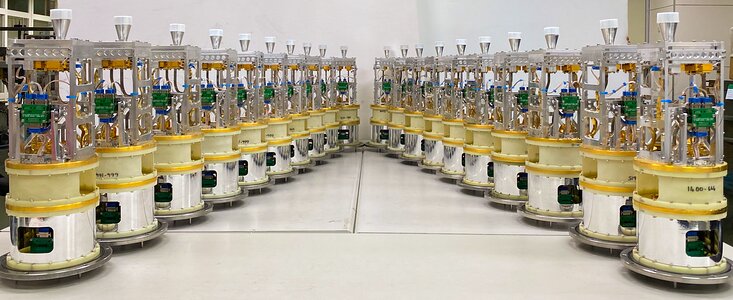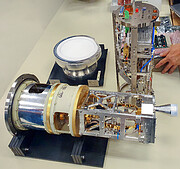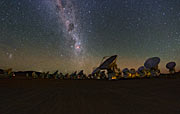Zprávy
ALMA goes to new (wave)lengths
New receivers that will allow ALMA to study the early Universe in longest wavelengths yet successfully tested
8. září 2021
First light has been achieved for a new set of receivers installed on the Atacama Large Millimetre/submillimetre Array (ALMA), in which ESO is a partner. The band 1 receivers pick up radio waves between 6 and 8.5 mm in length, setting a new record for the longest wavelengths that ALMA can observe. They will allow astronomers to view the early, distant Universe and to explore how planets form as never before.
To capture radiation from cosmic sources over a broad range of wavelengths, ALMA’s 66 antennas, located on the Chajnantor plateau in Chile, are equipped with precisely tuned receivers. Each receiver type is sensitive to a particular "band" or range of wavelengths of the electromagnetic spectrum. Until recently, eight out of a planned ten receivers had been mounted on the antennas, covering altogether the window between 0.3 and 3.6 mm (bands 10 to 3).
Now, thanks to band 1 receivers, ALMA will be equipped to observe at even longer wavelengths of light, opening a new window to explore the Universe. Scientists hope to be able to study gas in the reionisation epoch of the Universe, the time when the first stars and galaxies formed. In addition, as it is able to detect larger dust grains than the other ALMA bands, band 1 is ideal to look at the growth of such grains in discs around stars, allowing astronomers to gain more insight into how planets form.
The development of the ALMA band 1 receivers has been led by Taiwan’s Academia Sinica Institute of Astronomy and Astrophysics (ASIAA), accompanied by an international team comprising the National Astronomical Observatory of Japan (NAOJ), the University of Chile, the National Radio Astronomy Observatory (NRAO), the Herzberg Institute of Astrophysics in Canada and the National Chung-Shan Institute of Science and Technology in Taiwan. The University of Chile has been involved in the project since the beginning, helping to develop and produce optical elements such as the lenses and horn antennas for the band 1 receivers.
Recently, the ALMA board signed a contract for the development of the final, band 2, set of ALMA receivers, which will be led by a consortium of European institutions.
More Information
ALMA is a partnership of ESO (representing its member states), NSF (USA) and NINS (Japan), together with NRC (Canada), MOST and ASIAA (Taiwan), and KASI (Republic of Korea), in cooperation with the Republic of Chile. The Joint ALMA Observatory is operated by ESO, AUI/NRAO and NAOJ.
The band 1 research project was supported in Taiwan by Academia Sinica and grants from the Ministry of Science and Technology of Taiwan.
Kontakty
Ciska Kemper
European ALMA Programme Scientist
European Southern Observatory
Garching bei München, Germany
Tel: +49 89-3200-6447
Email: Francisca.Kemper@eso.org
Bárbara Ferreira
ESO Media Manager
Garching bei München, Germany
Mobile: +49 151 241 664 00
Email: press@eso.org
O zprávě
| Id: | ann21012 |
Our use of Cookies
We use cookies that are essential for accessing our websites and using our services. We also use cookies to analyse, measure and improve our websites’ performance, to enable content sharing via social media and to display media content hosted on third-party platforms.
ESO Cookies Policy
The European Organisation for Astronomical Research in the Southern Hemisphere (ESO) is the pre-eminent intergovernmental science and technology organisation in astronomy. It carries out an ambitious programme focused on the design, construction and operation of powerful ground-based observing facilities for astronomy.
This Cookies Policy is intended to provide clarity by outlining the cookies used on the ESO public websites, their functions, the options you have for controlling them, and the ways you can contact us for additional details.
What are cookies?
Cookies are small pieces of data stored on your device by websites you visit. They serve various purposes, such as remembering login credentials and preferences and enhance your browsing experience.
Categories of cookies we use
Essential cookies (always active): These cookies are strictly necessary for the proper functioning of our website. Without these cookies, the website cannot operate correctly, and certain services, such as logging in or accessing secure areas, may not be available; because they are essential for the website’s operation, they cannot be disabled.
Functional Cookies: These cookies enhance your browsing experience by enabling additional features and personalization, such as remembering your preferences and settings. While not strictly necessary for the website to function, they improve usability and convenience; these cookies are only placed if you provide your consent.
Analytics cookies: These cookies collect information about how visitors interact with our website, such as which pages are visited most often and how users navigate the site. This data helps us improve website performance, optimize content, and enhance the user experience; these cookies are only placed if you provide your consent. We use the following analytics cookies.
Matomo Cookies:
This website uses Matomo (formerly Piwik), an open source software which enables the statistical analysis of website visits. Matomo uses cookies (text files) which are saved on your computer and which allow us to analyze how you use our website. The website user information generated by the cookies will only be saved on the servers of our IT Department. We use this information to analyze www.eso.org visits and to prepare reports on website activities. These data will not be disclosed to third parties.
On behalf of ESO, Matomo will use this information for the purpose of evaluating your use of the website, compiling reports on website activity and providing other services relating to website activity and internet usage.
Matomo cookies settings:
Additional Third-party cookies on ESO websites: some of our pages display content from external providers, e.g. YouTube.
Such third-party services are outside of ESO control and may, at any time, change their terms of service, use of cookies, etc.
YouTube: Some videos on the ESO website are embedded from ESO’s official YouTube channel. We have enabled YouTube’s privacy-enhanced mode, meaning that no cookies are set unless the user actively clicks on the video to play it. Additionally, in this mode, YouTube does not store any personally identifiable cookie data for embedded video playbacks. For more details, please refer to YouTube’s embedding videos information page.
Cookies can also be classified based on the following elements.
Regarding the domain, there are:
- First-party cookies, set by the website you are currently visiting. They are stored by the same domain that you are browsing and are used to enhance your experience on that site;
- Third-party cookies, set by a domain other than the one you are currently visiting.
As for their duration, cookies can be:
- Browser-session cookies, which are deleted when the user closes the browser;
- Stored cookies, which stay on the user's device for a predetermined period of time.
How to manage cookies
Cookie settings: You can modify your cookie choices for the ESO webpages at any time by clicking on the link Cookie settings at the bottom of any page.
In your browser: If you wish to delete cookies or instruct your browser to delete or block cookies by default, please visit the help pages of your browser:
Please be aware that if you delete or decline cookies, certain functionalities of our website may be not be available and your browsing experience may be affected.
You can set most browsers to prevent any cookies being placed on your device, but you may then have to manually adjust some preferences every time you visit a site/page. And some services and functionalities may not work properly at all (e.g. profile logging-in, shop check out).
Updates to the ESO Cookies Policy
The ESO Cookies Policy may be subject to future updates, which will be made available on this page.
Additional information
For any queries related to cookies, please contact: pdprATesoDOTorg.
As ESO public webpages are managed by our Department of Communication, your questions will be dealt with the support of the said Department.





